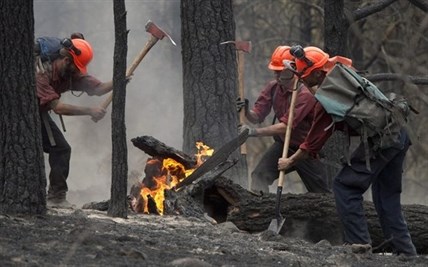
Firefighters tackle a flare up at the Smith Creek fire located on a hillside in West Kelowna, B.C., Saturday, July, 19, 2014. Cooler weather and rainfall in parts of British Columbia have helped to quell wildfires across the province, but some areas in the southern and central interior are still facing an extreme danger rating.
Image Credit: THE CANADIAN PRESS/Jonathan Hayward
July 21, 2014 - 12:51 PM
WEST KELOWNA - Thousands of people displaced by a wildfire near Kelowna, B.C. were allowed to return to their homes Sunday, but dry conditions and lightning have kept firefighters busy throughout the western provinces and the Northwest Territories.
About 2,400 of the 2,500 people who were forced out by the blaze near the municipality of West Kelowna, B.C. were allowed back into their homes on Sunday, but were cautioned to be ready to leave again.
Kelly Kay of the Central Okanagan Regional District Emergency Operations Centre said evacuees should still be prepared to leave at a moment's notice.
Kay said authorities will be discussing the possibility of allowing the estimated 100 people still under an evacuation order back in their homes.
"We will be evaluating that situation," she said. "For those who do remain on evacuation order, they will have to check back in at the evacuation reception centres to get the additional food and accommodation vouchers."
Tracy Wynnyk of the B.C. Wildfire Management Branch said the cooler weather and higher humidity has allowed firefighters to contain 50 per cent of the blaze, up from about 30 per cent on Saturday.
While winds on Saturday evening were a concern, the gusts did not advance the 2.6-square-kilometre blaze past containment lines.
"It's going quite well," said Wynnyk. "They had a very quiet night on the fire."
But cooler weather has not helped quell a fire burning near Lytton, more than 150 kilometres northeast of Vancouver.
The 15-square-kilometre fire remained completely uncontained and the steep terrain is proving to be a concern for firefighters, said David Steeves of the B.C. Wildfire Management Centre.
The fire remained the same size it did Saturday, he said.
The blaze has forced out about 120 people from their homes and there is no word on when they will be allowed to return.
In the Northwest Territories, a 160,000-hectare fire continued to generate heavy smoke that prompted officials to periodically shut down traffic on Highway 3 into Yellowknife.
Crews were attempting to contain the fire on its south flank with bulldozers, but lightning sparked four new fires in the region over the weekend.
There were 188 fires still burning in the NWT on Sunday.
"We haven't had substantial rain in the Northwest Territories since the spring melt," said Judy McLinton, a spokeswoman for the environment and natural resources department.
"Any rain that you do get, a couple of days later you're right back into the dry conditions again."
"The long-term forecast is saying we're going to remain warm, dry and windy."
Cooler weather and rainfall in parts of British Columbia have helped to quell wildfires across the province, but some areas in the southern and central interior are still facing an extreme danger rating.
Approximately 100 firefighters from Ontario arrived in Edmonton on Saturday, many of whom were dispatched to help battle the Red Deer Creek wildfire which burned on the boundary between B.C. and Alberta. The fire was estimated to be 35,000 hectares in size on the weekend and was still listed as out of control.
Navi Saini, another spokeswoman for the B.C. fire management branch, said there were six new fire starts Saturday and one Sunday morning.
She said the weekend, though, has been "relatively quiet," so the department is hopeful the 151 active fires are diminishing in number and magnitude.
An extreme danger rating indicates a "very serious" fire risk where new fires start and spread easily.
Saini added that in general, the danger rating across B.C. has dropped.
She says there are more than 1,300 firefighters working across the province.
-By Steven Chua in Vancouver with files from Brian Pardoe in Toronto and Rob Drinkwater in Edmonton.
News from © The Canadian Press, 2014